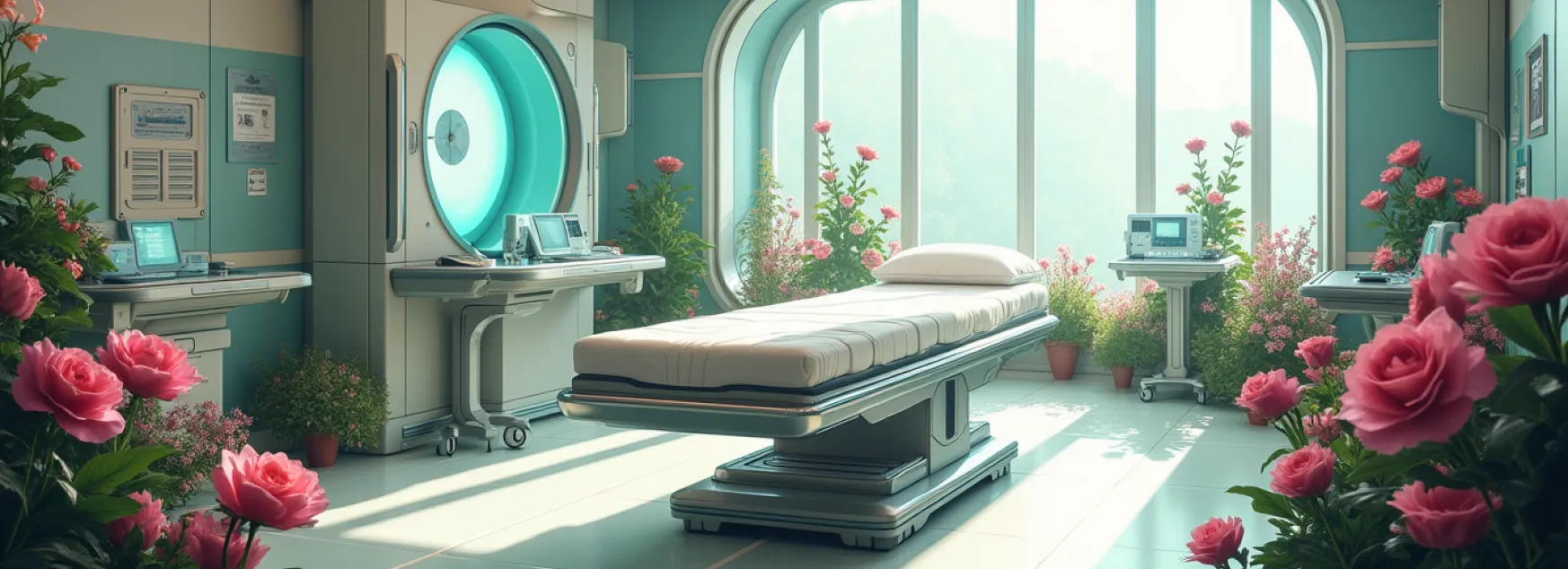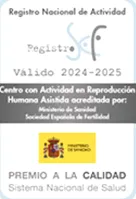Egg donation
What is
Egg Donation?
Process and Technique of IVF with Donor Eggs
Ovodonation involves using the eggs from an anonymous donor and fertilising them with the partner’s sperm to obtain embryos.
The process of ovarian stimulation and egg retrieval is performed on the donor. The donated egg is fertilised with a sperm from the partner, previously selected in the laboratory, mimicking the optimal conditions that would occur in the woman’s uterus.
EVADONNA: OWN EGG BANK
We have our own Egg Bank, which allows us to control the traceability and quality of the process at all times. The donors are between 18 and 33 years old and in perfect health.
We rule out infectious diseases and the main genetic and chromosomal alterations. Our EVA egg donation program guarantees the highest phenotypic (physical) and immunological similarity between the donor and the recipient. Additionally, they undergo a comprehensive psychological evaluation to rule out significant pathologies.
Study of success gestational
Study that we provide to you prior to the treatment, so that you are aware of the possibilities you have to achieve success in pregnancy in each cycle.
Fertility Studies

Selection of the donor
Since 2016, we have our own Egg Bank, and the selection of donors is a rigorous procedure perfectly regulated by law. The donors are between 18 and 33 years old and in perfect health. We rule out infectious diseases and the main genetic and chromosomal alterations. Additionally, they have a comprehensive psychological evaluation to rule out significant pathologies that could affect your future baby.
Our EVA egg donation program guarantees the maximum phenotypic (physical) and immunological similarity between the donor and the recipient. It is also important to note that the egg donor signs a consent form, in accordance with Spanish law, in which she guarantees that she donates voluntarily and anonymously.

Preparation of the donor
The donor undergoes the same medication treatment as an IVF patient with her own eggs. Through the administration of medication, what we aim to do is stimulate the ovaries and induce the production of the highest number of oocytes. We monitor the process with the same ultrasound and analysis controls as an IVF patient, until the day of the puncture, when the mature oocytes will be extracted in the operating room and under sedation.
At this point, if it happens that the donor is undergoing treatment at the same time as you, the oocytes will be used for your fresh cycle; if not, the oocytes will be vitrified with the most advanced technology and the strictest traceability control.

IVF and Embryo Culture
On the day of the fertilisation of the donor’s oocytes, the insemination of the oocytes will be performed in the laboratory with the couple’s sperm.
When fertilisation occurs, the embryos are left in culture for 5 to 6 days. During this entire time, the embryologists monitor and evaluate the development of the embryos using timelapse incubators.

Preparation of the recipient
To prepare the endometrium, the patient undergoes a simple treatment. It consists of the administration of hormones, oestrogens, and progesterone, either transdermally or orally, so that the endometrium is in the best possible condition at the time of embryo transfer.

Embryo transfer
Embryo transfer is the final and decisive step. It is a crucial phase of the treatment.
The specialist prepares the patient’s uterus with medication and ensures that it has the correct thickness for embryo implantation. On the 5th or 6th day of embryo culture, the highest quality embryo is transferred to the uterus through a simple procedure performed in the operating room. Using a specific and flexible catheter, to avoid damaging the walls of the uterine cavity, the embryo is deposited into the uterine cavity. No sedation is needed as it is not a painful procedure.
After the embryo transfer, the patient will rest for a few minutes and can resume her daily activities, always in moderation.
The surplus embryos from the process will be frozen, in order to avoid repeating the ovarian stimulation and follicular puncture process again, in case you do not get pregnant in the first cycle of in vitro fertilisation.

Post-transfer process
Approximately two weeks after the embryo transfer, the pregnancy test is performed. Two possibilities are considered after the embryo transfer:
- If the patient becomes pregnant, we discharge her and she begins gynaecological follow-up of her pregnancy with her professional. This is not a final point in the relationship with Clínicas Eva; we want to know about the patient, her pregnancy, and of course, meet her baby.
- In case of not achieving pregnancy, we begin to develop a second strategy. In assisted reproduction, success is not always achieved on the first attempt. We support the patient and her partner with psychological assistance and begin a second IVF cycle.
How long does the
Egg Donation?
It depends on each case, ovodonation can take up to 2 months since the goal is to find a donor with the maximum similarity to the patient. Additionally, their menstrual cycles must be synchronised.
Additionally, prior to the treatment, tests will be conducted to make the treatment as personalised as possible. These tests are focused on achieving the couple’s dream, so the final duration may vary depending on each patient’s situation.
When to resort to the
egg donation?
Egg donation is intended for couples where, due to various reasons such as age, surgical interventions, or illnesses, it is not possible to use the patient’s egg. Thanks to egg donation, these patients can fulfil their dream of becoming parents.
Woman
Women with ovarian problems: primary or premature ovarian failure.
Women with ovarian dysfunction and loss of egg quality.
Women with hereditary diseases that can be transmitted to their offspring and that cannot be detected by Preimplantation Genetic Diagnosis techniques.
Women who have had repeated failures of In Vitro Fertilisation with their own eggs.
Women with severe endometriosis.
Women over 43 years old, as from this age the pregnancy rate drops significantly.
Cases of recurrent miscarriages.
Women who suffer from any illness that contraindicates ovarian stimulation.
LÍDERES EN REJUVENECIMIENTO OVÁRICO Y ENDOMETRIAL
QUÉDATE EMBARAZADA CON TUS PROPIOS ÓVULOS
OVARIAN REJUVENATION
Ovarian Rejuvenation is a specific treatment to improve the quantity of the patient’s eggs. It consists of injecting an infusion of plasma rich in growth factors, obtained from the patient’s own blood platelets, into the ovaries.
HYPERBARIC CHAMBERS
Hyperbaric medicine uses hyperbaric oxygen at a higher pressure than normal to increase the concentration of oxygen in the patient’s blood. In fertility there are studies for both men and women that show that hyperbaric oxygen benefits fertility.
REJUVENATION OF THE UTERUS
Plasma rich in growth factors is also beneficial for the uterus due to its regenerative and reparative properties. It is obtained from the patient’s own blood platelets, concentrating all the factors in a small portion of plasma and then infused into the uterus.
WHEN WILL THE RESULTS BE SEEN?
The results after the first plasma injection may be noticeable in the first consecutive IVF cycle, but depending on the patient, a second treatment of plasma rich in growth factors may be needed.
LEADERS IN OVARIAN AND ENDOMETRIAL REJUVENATION
GET PREGNANT WITH YOUR OWN EGGS
OVARIAN REJUVENATION
Ovarian Rejuvenation is a specific treatment to improve the quantity of the patient’s eggs. It consists of injecting an infusion of plasma rich in growth factors, obtained from the patient’s own blood platelets, into the ovaries.
HYPERBARIC CHAMBERS
Hyperbaric medicine uses hyperbaric oxygen at a higher pressure than normal to increase the concentration of oxygen in the patient’s blood. In fertility there are studies for both men and women that show that hyperbaric oxygen benefits fertility.
REJUVENATION OF THE UTERUS
Plasma rich in growth factors is also beneficial for the uterus due to its regenerative and reparative properties. It is obtained from the patient’s own blood platelets, concentrating all the factors in a small portion of plasma and then infused into the uterus.
WHEN WILL THE RESULTS BE SEEN?
The results after the first plasma injection may be noticeable in the first consecutive IVF cycle, but depending on the patient, a second treatment of plasma rich in growth factors may be needed.

PLAN EVA
FINANCE YOUR PREGNANCY AT 100%
We know that every treatment involves an emotional and financial cost. That’s why we finance your pregnancy interest-free.

